As an Amazon Associate I earn from qualifying purchases.
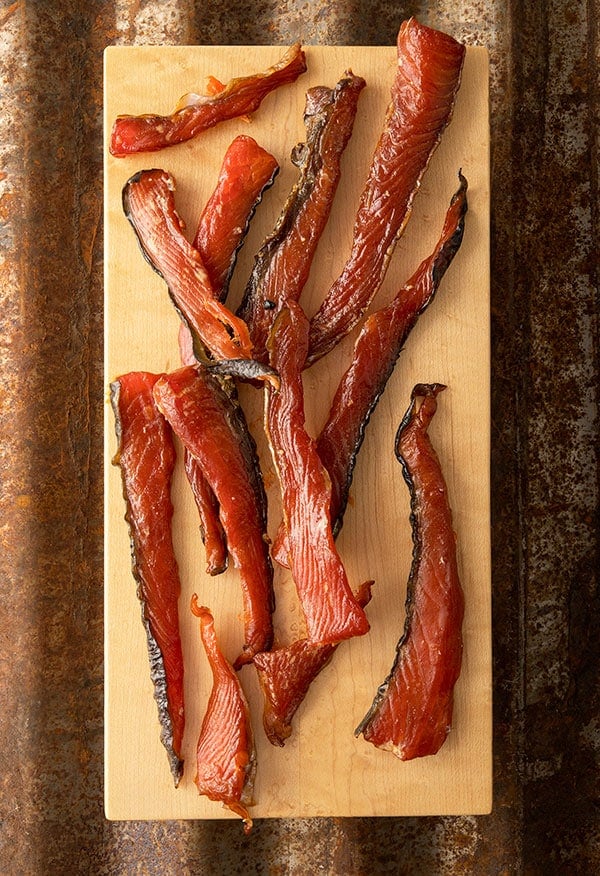
Salmon jerky is the logical extension of both regular smoked salmon as well as salmon candy.
The way I do all three is, more or less, the same. Only the cure, cut and times are different. Let me walk you through it. First, there is my standard smoked salmon recipe, which is well regarded, incidentally. This is hot-smoked salmon fillets or blocks, brined and basted with birch or maple syrup or honey. The intention is tender, lightly smoked but fully cooked salmon.
Then there is my salmon candy recipe. This is a half step towards salmon jerky. Instead of a brine, I salt (and sugar) relatively thick strips of salmon, then smoked them and baste them until they are a bit sturdier than my smoked salmon. This allows them to be carried along on day trips, and they’ll keep a long while in cool conditions.
But salmon candy will still go bad at room temperature after a few days. That’s where salmon jerky comes in. It’s the same basic cure as salmon candy, but for longer, the cuts are thinner and the smoke time is longer.
The most important thing to know about making salmon jerky is to slice it around 1/2 inch thick, from the tail to the head. This is important. If you do cross cuts, i.e., from top to bottom of the fish. the jerky will fall apart. I also would not slice thinner than about 1/4 inch, or you risk the jerky drying too much and turning brittle.
You will also notice I left the skin on. It’s perfectly edible, and it helps keep the jerky together. If you don’t like it, peel the skin off before you eat it.
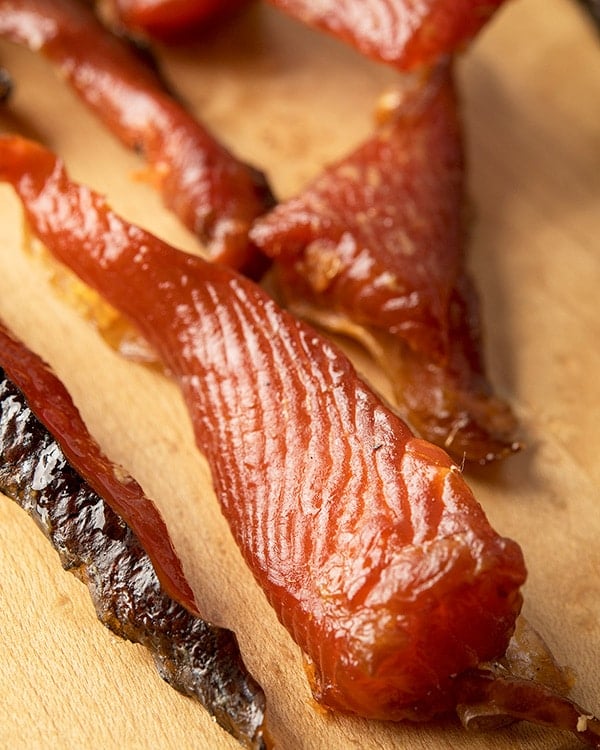
When done right, the finished product is chewy, a bit salty and a bit sweet.
I like it a lot as a trail snack, road trip food, or to eat while catching more salmon.You can play with things a bit, too. The initial amount of sugar in the cure is mostly to remove water from the fish, the same way salt does. Sugar mitigates the harshness of pure salt. But if you can’t have sugar at all in your diet, you can replace the sugar with more salt.
If by chance you forget about things and leave the fish in the cure too long, you can dunk them in a bowl of ice water to remove excess cure. In this case, it’s better to err on more time in the cure than less, because you are shooting for preservation.
As for the flavoring, I still like my maple or birch syrup baste. (You can buy birch syrup made by my friend Sam Thayer here.) But you can go with black pepper pressed into the fish after it cures and before it’s smoked, or chile powder or garlic or really whatever makes you happy. Or do a variety.
Wood choice is up to you, too, but I recommend alder, maple or fruit woods.
Let your salmon jerky cool on a rack after it’s been smoked until it hits room temperature, then put it in a container in the fridge.
Salmon Jerky
Ingredients
- 4 pounds salmon, cut in strips
- 1 cup kosher salt
- 1 cup brown sugar
- 1/2 cup maple syrup or birch syrup
Instructions
- Mix the salt and sugar together. Sprinkle a thin layer of this over the bottom of a lidded container. Arrange the strips of salmon in the container in one layer. Cover with the remaining cure. If you need to do this in more than one layer, heavily dust the first layer with the cure before adding more fish.
- Cover the container and let this cure in the fridge for 6 hours. If you can, turn the container upside down once during this time, or mix the salmon pieces around, so you get a more even cure.
- Remove your salmon from the cure and quickly dunk it in a large bowl of ice water to rinse off excess cure. Pat the fish dry with paper towels and set on a rack over a baking sheet in the fridge overnight if possible, or in front of a fan or in a cool, shaded, breezy place for at least 1 hour. You want the surface of the salmon to get sticky-tacky, which will help smoke adhere to it.
- Fire up your smoker. I generally smoke at about 200°F. See the headnotes for your wood choices. Smoke you salmon for at least 3 hours, and as long as it takes to get dried, but still chewy. It normally takes me 5 hours. If you are using maple syrup, paint it on the fish every 30 minutes or so after 1 hour has elapsed.
- Once you have salmon jerky, put it back on the cooling rack to return to room temperature. It will keep in cool room temperature, i.e., 60°F or below, for a long while, but I keep my jerky in small, vacuum sealed packets in the fridge until I need it. It should last like this for months.
Notes
Nutrition
Nutrition information is automatically calculated, so should only be used as an approximation.
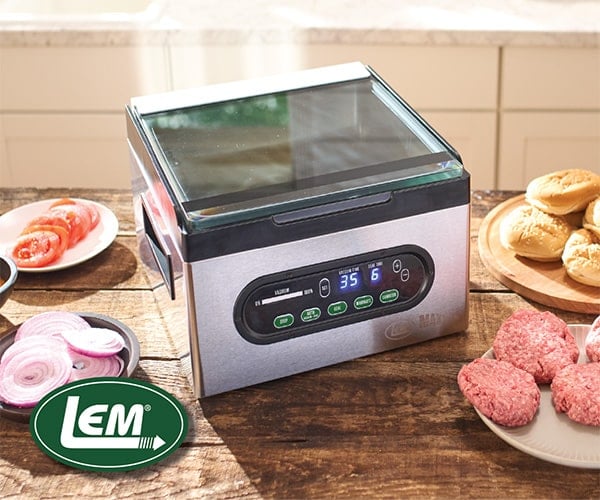
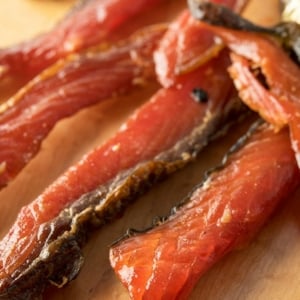
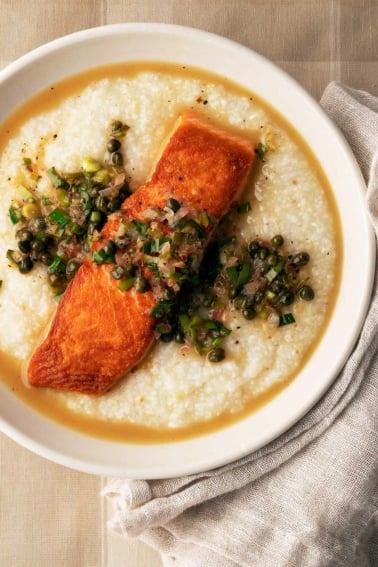
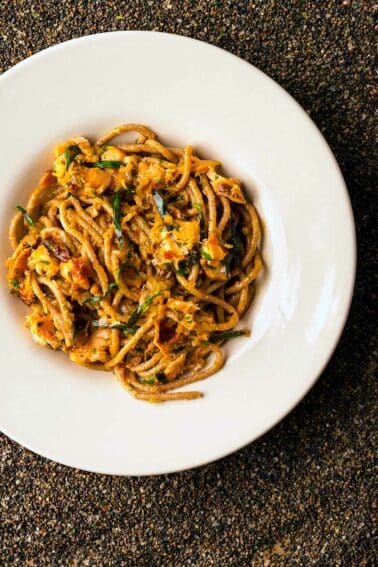
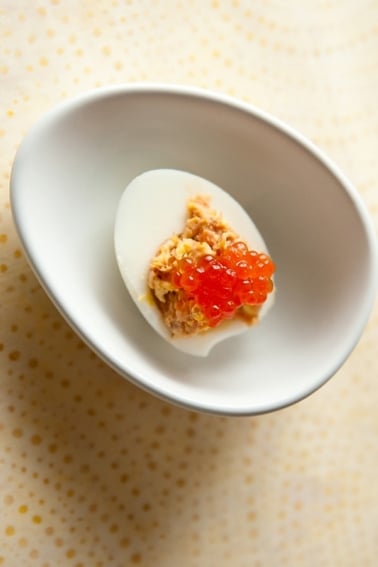
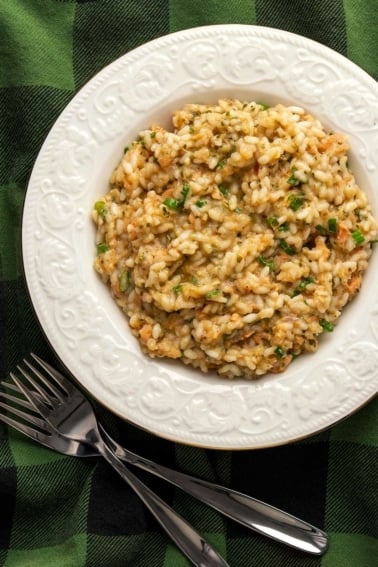
way too salty, I would use 1/2 cup of salt to 3 cups of brown sugar and follow the rest of your recipe.
Just made this for the second time and it turned out fantastic. I used a 3-2 ratio (3 cups brown sugar 2 cups coarse kosher salt) and brined for 3 hours, cleaned the salmon well and let sit overnight in the fridge for roughly 8 hours. It seems to be just perfect for my liking. Not too salty, not too sweet. Smoked for 5 hours at 200 degrees basting with maple syrup every hour. I used Chinook Salmon from Lake Sakakawea in North Dakota.
This recipe is excellent. I however cured for just 3 hours and used 3/4 cups of kosher salt and 1 and a 1/4 cup of golden sugar for the cure. Worked well for me and I didn’t find it too salty (used moyen kosher salt). Maybe someone who thinks this recipe is too salty could try that. Used pink salmon as well as Chinook (or king for the Americans in the room). Really appreciate the recipe, will be referring to this again. Cheers!
Hi Hank!
Excited to try your recipe. I only have access to a cold smoker; how should adapt the recipe, if possible? My goal is still to have jerky that can be kept unrefrigerated for multiple days.
Thanks in advance!
Marie: I don’t believe this is possible with a cold smoker, sorry. The idea is to dry it out until it’s leathery and salty. Maybe smoke for a few hours then put in a dehydrator?
If you don’t have a smoker, can you add a little liquid smoke to the brine?
I have a Big Chief electric smoker. Temperature wise it maintains a steady 165 – 170 degrees. How long would you recommend smoking the salmon jerky in this unit?
Chuck: As long as it takes. You want the jerky to be leathery and mostly dried, but not brittle. Can take anywhere from 2 to 8 hours.
Just a general comment, as my wife keeps requesting your smoked salmon recipe, which we think is devine. I always use “Diamond Crystal kosher salt”, could it be that those experiencing too much salt are using Morten’s Kosher salt, which weighs more per cup? Just a thought.
Stephen: That’s possible, if they are not weighing salt. I always urge people to weigh their salt in these preparations, not use volumetric measurements for exactly that reason.
I followed the recipe exactly and it was way too salty. I like salt, but this was overpowering. The amount of salt needs to be cut in half.
The recipe works well for most. I suspect your salmon was thinner than mine, or you left it in the cure too long, or you didn’t rinse it. It is supposed to be pretty salty, but pleasingly so.
what should the weight of your salt be as it’s only listed as kosher. Twice now it came out way to salty. thanks
Brian: In this case you really want it salty. This is a preservation recipe, and this stuff can keep at an Alaskan room temp a while. But if it’s still too salty, use the same amount of salt and sugar, but cure for less time, maybe start with 6 hours instead of 12.
I first tasted salmon jerky in Alaska in 1989…it was our go to snack while hiking and camping up there. It was relatively cheap in stores there, then. I have found something similar there in stores, recently, but it is now pretty pricey! Never could find it anywhere else in the lower NW US.
I go to Alaska yearly for coho season….smoke some (recipe very similar to yours without maple syrup) and vacuum seal many pounds to bring home. Will have to try adding some maple syup basting.
I have been looking for a recipe for salmon jerky for years……..this sounds and looks like what I had 1989!
I definitely will try your recipe this year!
Thanks for great recipes…..
thanks it turn out great
Hella salty, definitely reduce salt quality, or cure time. burns your mouth
Can this be made on a grill or the oven if you do t have a smoker?
Suzanne: Maybe a low oven? It’s really best smoked, or just dehydrated. But if you have convection and can run your oven below 200F you should be OK.
Can jerky be made from frozen cold-smoked salmon? Perhaps I could cut it into strips, add the maple syrup, and smoke it until it gets dry enough?
Mine turned out incredibly salty (unedible). I followed instructions to a T. Any idea why this would have been?
Sean: My guess is that your salt tolerance is lower than mine. The 12 hour soak really makes a durable, and yes, salty, jerky. One that keeps a long time. I am sorry yours came out too salty, but if you do this again, pull the fish out of the brine at 6 hours and try that. As for this batch, use it as a salty accent in rice, or with pasta — flake it out or chop and mix it into things, leaving out salt in the rest of that recipe.
Got it, thanks Hank!
I would think an EQ cure ratio would work well here also. +/- 3% salt by weight of salmon, and do a 24ish hour cure(penetration time should be quick with the salmon cut into thin strips) in a vacuum bag. That way you could dial in the level of salt closer that a salt box method. I’ve had good luck making lox with eq cures over traditional brines and salt boxes.
my guy eats it straight from the packet
Hi Hank,
is there a way to make this low carb and without all the sugar? Or is the sugar needed for preservation?
Poldi: you can skip the sugar, but the flavor will be a little harsher.
Can Splenda be used, instead?
Julie: I wouldn’t. I’d just use less or no sugar.